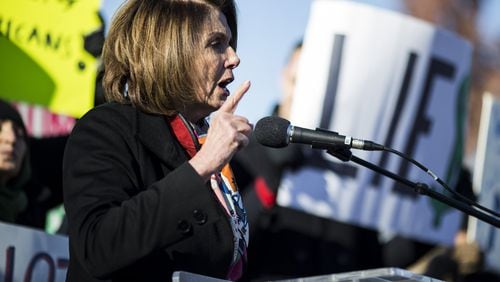On the heels of a generally favorable jobs report, House Minority Leader Nancy Pelosi, D-Calif., criticized Republicans for failing to boost wages for American workers.
“November’s jobs report reveals that hard-working Americans still aren’t getting the bigger paychecks they deserve,” Pelosi said in a statement she tweeted out. She said Republicans had promised higher wages for working families and “failed to deliver.”
Her talking point is a stretch: Federal data show wage growth since President Donald Trump took office in January, though one of the two measurements shows the gains barely outpacing inflation.
One of the two key statistics for judging this statement is median usual weekly inflation-adjusted earnings for full-time wage and salary workers age 16 and over. This information is collected by the Bureau of Labor Statistics and is available quarterly.
For the last quarter fully under President Barack Obama, the fourth quarter of 2016, this was $348.
After Trump took office, it rose to $350 in the first quarter of 2017, rose again to $354 in the second quarter, and remained the same at $354 in the third and most recent quarter.
The $6 increase may not seem like much, but it’s still almost a 2 percent increase above the rate of inflation over just three quarters, and that runs counter to the point Pelosi was trying to make.
“Generally speaking, earnings increase during economic expansions,” said Chris Lafakis, a director at Moody’s Analytics. “There can be some debate over how much wage growth a healthy economy should have, and who is responsible for the growth, but it can’t be debated that earnings increased under President Obama and they have continued to increase under President Trump.”
We also looked for wage growth in another BLS statistic, average hourly earnings for all private-sector employees.
This statistic shows a slow but steady rise in wages, from $25.98 in December 2016 to $26.55 in November.
There’s a reason these two statistics can look a little different. The time period studied is different (hourly vs. weekly), as is the typical case studied (median vs. average). This statistic is also released every month rather than every quarter.
The most important difference, however, is that the BLS does not adjust the hourly earnings data for inflation. When adjusted for inflation, the earnings gains on Trump’s watch are smaller. When Gary Burtless, a Brookings Institution economist, ran an inflation adjustment for us, he found that in 2017, average hourly earnings rose by 0.05 percent.
That’s an increase, but it’s barely outpacing inflation.
When we checked with Pelosi’s office, they cited a statement by Gary Cohn, the White House’s own National Economic Council director, who said on CNBC’s Squawk Box that “we’re still not growing wages in this country.”
They also said that in January 2016, House Speaker Paul Ryan, R-Wis., tweeted that “wages are stagnant” even though at the time, they were growing at least as fast as they are today.
Our ruling
The two best statistics for judging Pelosi's assertion both show wage growth. One shows growth that's barely above inflation, meaning Americans wouldn't necessarily keep any more of their income in their pocket. We rate her statement Mostly False.
“Even with full control of the House, Senate and White House, Republicans have still failed to deliver on their promise of higher wages for working families.”
— Rep. Nancy Pelosi, D-Calif., on Friday, Dec. 8, 2017 in a statement released by her office
About the Author






